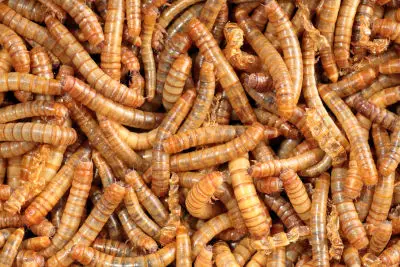Why Does a Lizard Tail Move After It Dies? Explained
Lizards are known for their unique ability to shed their tails as a defense mechanism when threatened by predators. However, have you ever noticed that even after a lizard’s tail is detached from its body, it continues to move for some time? This phenomenon has puzzled scientists for decades.
The movement of a lizard’s tail after it has been detached from its body is known as reflex motion. This occurs because the tail contains nerve cells that continue to fire after the tail has been severed. These nerve cells are responsible for the tail’s movement, which can last for several minutes or even hours after the tail has been detached.
| Are these foods dangerous for your Beardie? | |
| Avacado? Click here to learn, from this guide, if this food is dangerous |  |
| Superworms? Click here to learn, from this guide, if this food is dangerous |  |
Scientists believe that this reflex motion is an evolutionary adaptation that helps the lizard to escape from predators. By continuing to move after the tail has been detached, the lizard’s tail distracts the predator and allows the lizard to make a quick getaway. While this may seem like a gruesome process, it is actually a survival mechanism that has allowed lizards to thrive in their natural habitats for millions of years.
Biological Mechanism of Post-Mortem Tail Movement
Autotomy in Lizards
Lizards have a unique ability to detach their tails when they feel threatened or are attacked by predators. This process, known as autotomy, allows the lizard to escape from the predator’s grasp while leaving behind a wriggling tail that distracts the predator. The tail continues to move for a short period after detachment due to the stored energy in the muscles.
Nervous System and Reflexes
The nervous system plays a vital role in the post-mortem movement of the lizard tail. Even after death, the nervous system remains active for a short period, and the reflexes can still be triggered. In the case of the lizard tail, the reflexes can be triggered by various stimuli, such as touch or pressure, leading to the movement of the tail.
Muscle Contraction and Relaxation
Muscle contraction and relaxation are also crucial in the post-mortem movement of the lizard tail. When the lizard dies, the muscles in the tail lose their oxygen supply, leading to the buildup of lactic acid. This accumulation of lactic acid causes the muscles to contract, leading to the movement of the tail. As the lactic acid continues to build up, the muscles eventually become exhausted, leading to the relaxation of the muscles and the cessation of tail movement.
In conclusion, the post-mortem movement of the lizard tail is a result of a combination of factors, including autotomy, the nervous system and reflexes, and muscle contraction and relaxation. Understanding these mechanisms can provide valuable insights into the biology and behavior of lizards.
Evolutionary Advantages of Tail Autotomy
Predator Evasion
Lizards have evolved a unique defense mechanism, known as tail autotomy, which allows them to escape from predators. When a predator catches a lizard by its tail, the lizard can voluntarily detach its tail to distract the predator and make a quick escape. The detached tail continues to move for a few minutes, which confuses the predator and gives the lizard enough time to run away.
This mechanism has been observed in many species of lizards and is an effective way to evade predators. The tail of a lizard contains a high concentration of nerves, which allows it to sense danger and react quickly. This ability to detach the tail when threatened has given lizards a significant advantage in the wild.
Regeneration and Energy Allocation
Another advantage of tail autotomy is the ability of lizards to regenerate their tails. After the tail is detached, the lizard can grow a new tail, which is a crucial survival mechanism. The regenerated tail is not an exact replica of the original tail, but it does serve the same purpose.
Regenerating a tail requires a lot of energy, and lizards have evolved to allocate resources efficiently. By detaching their tails, lizards can conserve energy and use it to grow a new tail when needed. This ability to regenerate a tail is unique to lizards and has played a significant role in their survival and evolution.
In conclusion, tail autotomy is an essential adaptation that has helped lizards survive in the wild. It provides them with an effective way to evade predators and conserve energy for regeneration. Lizards have evolved this mechanism over millions of years, and it has proven to be a successful survival strategy.
Scientific Observations and Studies
Research on Lizard Tail Autotomy
Scientific studies have shown that lizards have the ability to voluntarily shed their tails as a defense mechanism when they are threatened by predators. This process, known as autotomy, allows the lizard to escape from the predator’s grasp by leaving behind a wriggling tail that distracts the predator while the lizard makes its escape. Autotomy is a well-known phenomenon in the animal kingdom, and lizards are one of the most well-known examples of this behavior.
Analysis of Post-Mortem Movement
After a lizard dies, it is not uncommon for its tail to continue to twitch or move for a short period of time. This movement is often mistaken for the lizard still being alive, but it is actually a post-mortem reflex caused by the contraction of muscles in the tail. Scientists have studied this phenomenon and have found that the movement is caused by the buildup of lactic acid in the muscles of the tail. This buildup of lactic acid causes the muscles to contract and spasm, which produces the movement that is observed.
In conclusion, scientific research has provided a clear understanding of why a lizard’s tail moves after it dies. Autotomy is a well-known defense mechanism in lizards, while the post-mortem movement of the tail is caused by the buildup of lactic acid in the muscles. These scientific observations and studies have helped to shed light on this interesting phenomenon in the animal kingdom.